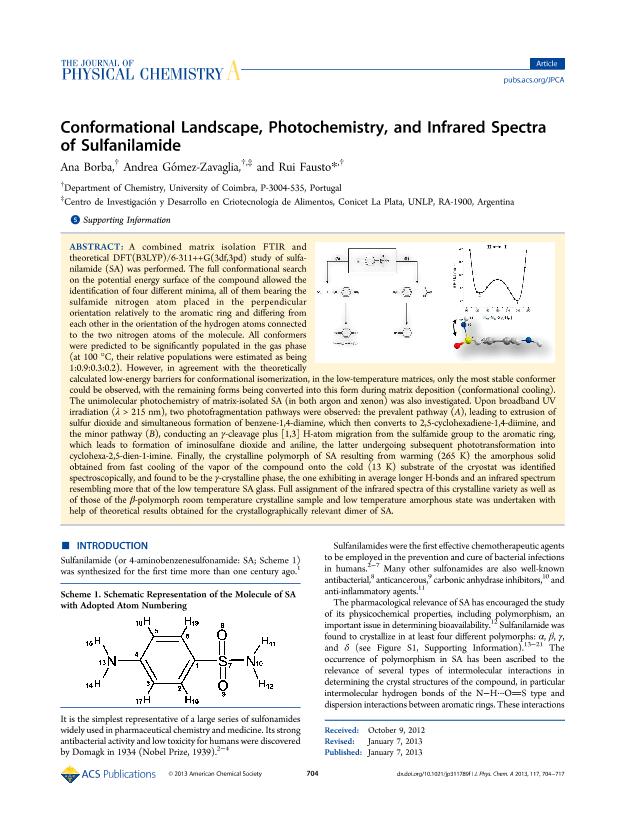Artículo
Conformational Landscape, Photochemistry, and Infrared Spectra of Sulfanilamide
Fecha de publicación:
01/2013
Editorial:
American Chemical Society
Revista:
Journal Of Physical Chemistry A
ISSN:
1089-5639
e-ISSN:
1520-5215
Idioma:
Inglés
Tipo de recurso:
Artículo publicado
Clasificación temática:
Resumen
A combined matrix isolation FTIR and theoretical DFT(B3LYP)/6-311++G(3df,3pd) study of sulfanilamide (SA) was performed. The full conformational search on the potential energy surface of the compound allowed the identification of four different minima, all of them bearing the sulfamide nitrogen atom placed in the perpendicular orientation relatively to the aromatic ring and differing from each other in the orientation of the hydrogen atoms connected to the two nitrogen atoms of the molecule. All conformers were predicted to be significantly populated in the gas phase (at 100 °C, their relative populations were estimated as being 1:0.9:0.3:0.2). However, in agreement with the theoretically calculated low-energy barriers for conformational isomerization, in the low-temperature matrices, only the most stable conformer could be observed, with the remaining forms being converted into this form during matrix deposition (conformational cooling). The unimolecular photochemistry of matrix-isolated SA (in both argon and xenon) was also investigated. Upon broadband UV irradiation (λ > 215 nm), two photofragmentation pathways were observed: the prevalent pathway (A), leading to extrusion of sulfur dioxide and simultaneous formation of benzene-1,4-diamine, which then converts to 2,5-cyclohexadiene-1,4-diimine, and the minor pathway (B), conducting an γ-cleavage plus [1,3] H-atom migration from the sulfamide group to the aromatic ring, which leads to formation of iminosulfane dioxide and aniline, the latter undergoing subsequent phototransformation into cyclohexa-2,5-dien-1-imine. Finally, the crystalline polymorph of SA resulting from warming (265 K) the amorphous solid obtained from fast cooling of the vapor of the compound onto the cold (13 K) substrate of the cryostat was identified spectroscopically, and found to be the γ-crystalline phase, the one exhibiting in average longer H-bonds and an infrared spectrum resembling more that of the low temperature SA glass. Full assignment of the infrared spectra of this crystalline variety as well as of those of the β-polymorph room temperature crystalline sample and low temperature amorphous state was undertaken with help of theoretical results obtained for the crystallographically relevant dimer of SA.
Palabras clave:
Ftir
,
Matrix Isolation
,
Sulfanilamide
Archivos asociados
Licencia
Identificadores
Colecciones
Articulos(CIDCA)
Articulos de CENTRO DE INV EN CRIOTECNOLOGIA DE ALIMENTOS (I)
Articulos de CENTRO DE INV EN CRIOTECNOLOGIA DE ALIMENTOS (I)
Citación
Borba, Ana; Gomez Zavaglia, Andrea; Fausto, Rui; Conformational Landscape, Photochemistry, and Infrared Spectra of Sulfanilamide; American Chemical Society; Journal Of Physical Chemistry A; 117; 4; 1-2013; 704-717
Compartir
Altmétricas




